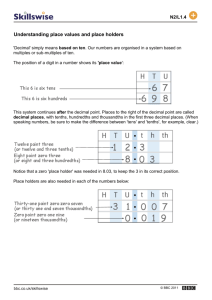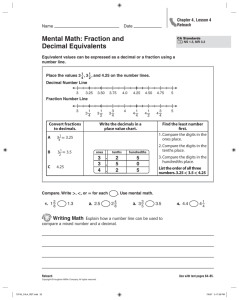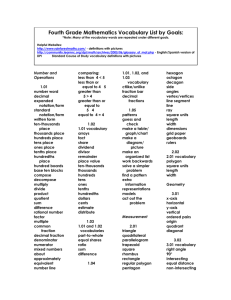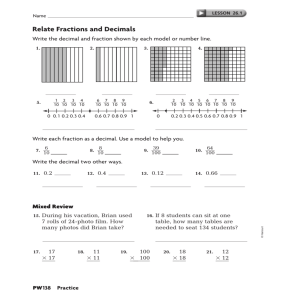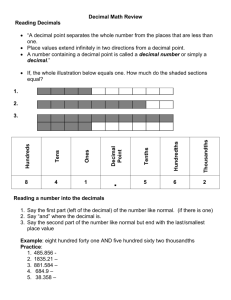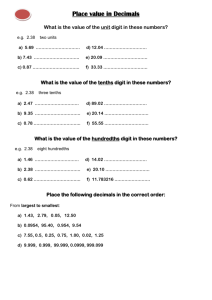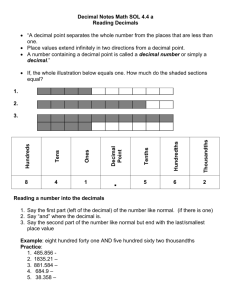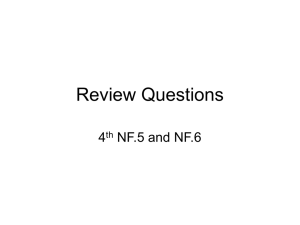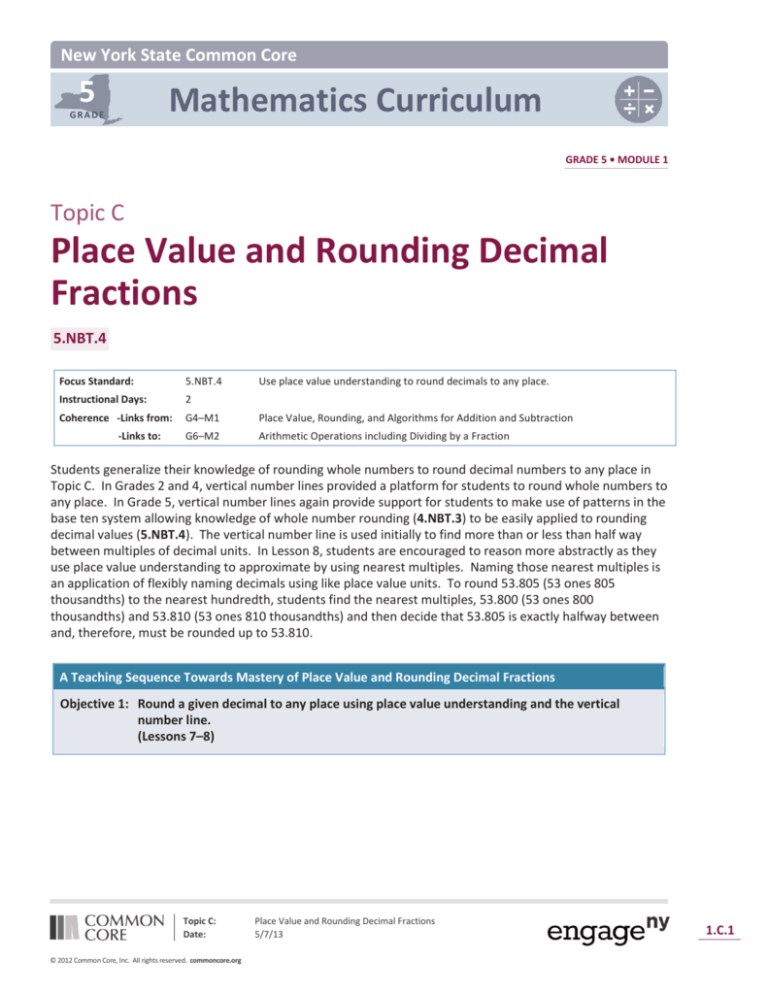
New York State Common Core
5
Mathematics Curriculum
GRADE
GRADE 5 • MODULE 1
Topic C
Place Value and Rounding Decimal
Fractions
5.NBT.4
Focus Standard:
5.NBT.4
Instructional Days:
2
Coherence -Links from:
G4–M1
Place Value, Rounding, and Algorithms for Addition and Subtraction
G6–M2
Arithmetic Operations including Dividing by a Fraction
-Links to:
Use place value understanding to round decimals to any place.
Students generalize their knowledge of rounding whole numbers to round decimal numbers to any place in
Topic C. In Grades 2 and 4, vertical number lines provided a platform for students to round whole numbers to
any place. In Grade 5, vertical number lines again provide support for students to make use of patterns in the
base ten system allowing knowledge of whole number rounding (4.NBT.3) to be easily applied to rounding
decimal values (5.NBT.4). The vertical number line is used initially to find more than or less than half way
between multiples of decimal units. In Lesson 8, students are encouraged to reason more abstractly as they
use place value understanding to approximate by using nearest multiples. Naming those nearest multiples is
an application of flexibly naming decimals using like place value units. To round 53.805 (53 ones 805
thousandths) to the nearest hundredth, students find the nearest multiples, 53.800 (53 ones 800
thousandths) and 53.810 (53 ones 810 thousandths) and then decide that 53.805 is exactly halfway between
and, therefore, must be rounded up to 53.810.
A Teaching Sequence Towards Mastery of Place Value and Rounding Decimal Fractions
Objective 1: Round a given decimal to any place using place value understanding and the vertical
number line.
(Lessons 7–8)
Topic C:
Date:
© 2012 Common Core, Inc. All rights reserved. commoncore.org
Place Value and Rounding Decimal Fractions
5/7/13
1.C.1
Lesson 7 5•1
NYS COMMON CORE MATHEMATICS CURRICULUM
Lesson 7
Objective: Round a given decimal to any place using place value
understanding and the vertical number line.
Suggested Lesson Structure
Fluency Practice
Application Problems
Concept Development
Student Debrief
Total Time
(12 minutes)
(8 minutes)
(30 minutes)
(10 minutes)
NOTES ON
MULTIPLE MEANS
OF REPRESENTATION:
(60 minutes)
Fluency Practice (12 minutes)
Find the Midpoint 5.NBT.4
(7 minutes)
Compare Decimal Fractions 5.NBT.3b
(2 minutes)
Rename the Units 5.NBT.2
(3 minutes)
Sprint: Find the Midpoint (7 minutes)
Vertical number lines may be a novel
representation for students. Their use
offers an important scaffold for
students’ understanding of rounding in
that numbers are quite literally
rounded up and down to the nearest
multiple rather than left or right as in a
horizontal number line. Consider
showing both a horizontal and vertical
line and comparing their features so
that students can see the parallels and
gain comfort in the use of the vertical
line.
Materials: (S) Personal white boards
Note: Practicing this skill in isolation will help students
conceptually understand rounding decimals in this lesson.
NOTES ON
MULTIPLE MEANS
OF ENGAGEMENT:
Compare Decimal Fractions (2 minutes)
Materials: (S) Personal white boards
Note: This review fluency will help students work towards
mastery of comparing decimal numbers, a topic they were
introduced to in Lesson 6.
T:
(Write 12.57 ___ 12.75.) On your personal boards,
compare the numbers using the greater than, less
than, or equal sign.
S: (Write 12.57 < 12.75 on boards.)
Repeat the process and procedure:
0.67 __
__0.084
Lesson 7:
Date:
© 2012 Common Core, Inc. All rights reserved. commoncore.org
Sprints like Compare Fractions may be
made more active by allowing students
to stand and use their arms to make
the > , < , and = signs in response to
teacher’s question on board.
328.2 __ 328.099
Round a given decimal to any place using place value
understanding and the vertical number line.
5/7/13
1.C.2
Lesson 7 5•1
NYS COMMON CORE MATHEMATICS CURRICULUM
4.07 __ forty-seven tenths
twenty-four and 9 thousandths___ 3 tens
Rename the Units (3 minutes)
Note: Renaming decimals in common units will strengthen student understanding of place value.
T:
S:
T:
S:
T:
S:
(Write 1.5 = ____ tenths.) Fill in the blank.
15 tenths.
(Write 1.5 = 15 tenths. Below it, write 2.5 = ____ tenths.) Fill in the blank.
25 tenths.
(Write 2.5 = 25 tenths. Below it, write 12.5 = ____ tenths.) Fill in the blank.
125 tenths.
Repeat the process for 17.5, 27.5, 24.5, 24.3, and 42.3.
Application Problems (8 minutes)
Craig, Randy, Charlie, and Sam ran in a 5K race on Saturday. They were the top 4 finishers. Here are their
race times:
Craig: 25.9 minutes
Randy: 32.2 minutes
Charlie: 32.28 minutes Sam: 25.85 minutes
Who won first place? Who won second place? Third? Fourth?
Concept Development (30 minutes)
Materials: (S) Personal white boards, place value charts, markers
Problem 1
Strategically decompose 155 using multiple units to round to the nearest ten and nearest hundred.
T: Work with your partner and name 155 using as many
hundreds as possible. Then name it using as many tens
as possible, and then using as many ones as possible.
Record your ideas on your place value chart.
1 hundred
16 tens = 160
5 tens
5 ones
15 tens + 5 ones = 155
15 tens
5 ones
+
155 ones
Lesson 7:
Date:
© 2012 Common Core, Inc. All rights reserved. commoncore.org
Round a given decimal to any place using place value
understanding and the vertical number line.
5/7/13
15 tens = 150
1.C.3
Lesson 7 5•1
NYS COMMON CORE MATHEMATICS CURRICULUM
T:
Which of these decompositions of 155 helps you round
this number to the nearest 10? Turn and talk.
S: 15 tens and 5 ones. The one that shows 15 tens. This
helps me see that 155 is between 15 tens and 16 tens
on the number line. It is exactly halfway, so 155 would
round to the next greater ten which is 16 tens or 160.
T: Let’s record that on the number line. (Record both
nearest multiples, halfway point, number being
considered, then circle rounded figure.)
T: Using your chart, which of these representations helps
you round 155 to the nearest 100? Turn and talk to
your partner about how you will round.
S: The one that shows 1 hundred. I can see that 155 is
between 1 hundred and 2 hundred. The midpoint
between 1 hundred and 2 hundred is 150. 155 is past
the midpoint, so 155 is closer to 2 hundreds. It rounds
up to 200.
T: Label your number line with the nearest multiples and
then circle your rounded number.
MP.6
2 hundreds = 200
155
1 hundred + 5 tens = 150
+
1 hundred = 100
Problem 2
Strategically decompose 1.57 to round to the nearest whole and nearest tenth.
T:
S:
Work with your partner and use your disks to name
1.57 using as many ones disks, tenths disks, and
hundredths disks as possible. Write your ideas on your
place value chart.
(Students work and share.)
1 one
5 tenths
7 hundredths
15tenths
7 hundredths
157 hundredths
T:
S:
What decomposition of 1.57 best helps you to round
this number to the nearest tenth? Turn and talk. Label
your number line and circle your rounded answer.
(Students share.)
16 tenths = 1.60
15 tenths + 7 hundredths = 1.57
15 tenths + 5 hundredths =
+1.55
15 tenths = 1.50
Bring to students’ attention that this problem set parallels conversions between meters and centimeters as
different units are being used to name the same quantity that is 1.57 meters = 157 centimeters.
Lesson 7:
Date:
© 2012 Common Core, Inc. All rights reserved. commoncore.org
Round a given decimal to any place using place value
understanding and the vertical number line.
5/7/13
1.C.4
Lesson 7 5•1
NYS COMMON CORE MATHEMATICS CURRICULUM
Problem Set 3
Strategically decompose to round 4.381 to the nearest ten, one, tenth, and hundredth.
T:
S:
Work with your partner and decompose 4.831 using as many tens, ones, tenths, and hundredths as
possible. Record your work on your place value chart.
(Students share.)
0 tens
4 ones
3 tenths
8 hundredths
1 thousandth
43 tenths
8 hundredths
1 thousandth
438 hundredths
1 thousandth
4381 thousandths
T:
S:
T:
S:
T:
We want to round this number to the nearest 10 first.
How many tens did you need to name this number?
No tens.
Between what two multiples of ten will we place this
number on the number line? Turn and talk. Draw your
number line and circle your rounded number.
(Students share.)
Work with your partner to round 4.381 to the nearest
one, tenth, and hundredth. Explain your thinking with
a number line.
Follow the sequence from above to guide students in realizing
that the number 4.381 rounds down to 4 ones, up to 44 tenths
(4.4), and down to 438 hundredths (4.38).
1 ten = 10
5 ones = 5
4 ones + 381
thousandths
0 tens = 0
+
Problem Set 4
Strategically decompose to round 9.975 to the nearest one, ten, tenth, and hundredth.
Follow the sequence above to lead students in rounding to the given places. This problem can prove to be a
problematic rounding case. However, naming the number with different units allows students to easily
choose between nearest multiples of the given place value. The decomposition chart and the number lines
are given below.
0 tens
9 ones
9 tenths
7 hundredths
5 thousandths
99 tenths
7 hundredths
5 thousandths
997 hundredths
5 thousandths
9975 thousandths
Lesson 7:
Date:
© 2012 Common Core, Inc. All rights reserved. commoncore.org
Round a given decimal to any place using place value
understanding and the vertical number line.
5/7/13
1.C.5
Lesson 7 5•1
NYS COMMON CORE MATHEMATICS CURRICULUM
ones
tens
10 ones = 10
tenths
1 ten = 10
9.975
9.975
9.5
9.5
9 ones =9
0 tens
hundredths
998 hundredths
100 tenths = 10
9.975
?
9.95
+
9.975
+
+
99 tenths = 9.9
95
997 hundredths
95
?
?
Repeat this sequence with 99.799 and round to nearest
ten, one, tenth, and hundredth.
Problem Set (10 Minutes)
Students should do their personal best to complete the Problem Set within the allotted 10 minutes. For some
classes, it may be appropriate to modify the assignment by specifying which problems they work on first.
Some problems do not specify a method for solving. Students solve these problems using the RDW approach
used for Application Problems.
On this Problem Set, we suggest all students begin with
Problems 1, 2, 3, and 5 and possibly leave Problem 4 to
the end if they still have time.
Before circulating while students work, review the
debrief questions relevant to the Problem Set so that
you can better guide students to a deeper
understanding of and skill with the lesson’s objective.
Student Debrief (10 minutes)
Lesson Objective: Round a given decimal to any place
using place value understanding and the vertical
number line.
The Student Debrief is intended to invite reflection and
active processing of the total lesson experience.
Invite students to review their solutions for the
Problem Set. They should check work by comparing
Lesson 7:
Date:
© 2012 Common Core, Inc. All rights reserved. commoncore.org
Round a given decimal to any place using place value
understanding and the vertical number line.
5/7/13
1.C.6
NYS COMMON CORE MATHEMATICS CURRICULUM
Lesson 7 5•1
answers with a partner before going over answers as a class. Look for misconceptions or misunderstandings
that can be addressed in the Debrief. Guide students in a conversation to debrief the Problem Set and
process the lesson. You may choose to use any combination of the questions below to lead the discussion.
In Problem 2, which decomposition helps you
most if you want to round to the hundredths
place? The tens place? Ones place? Why?
How was Problem 1 different from both Problem 2 and 3? (While students may offer many
differences, the salient point here is that Problem 1 is already rounded to the nearest hundredth
and tenth.)
Unit choice is the foundation of the current
lesson. Problem 3 on the activity sheet offers
an opportunity to discuss how the choice of
unit affects the result of rounding. Be sure to
allow time for these important understandings
to be articulated by asking the following: If a
number rounds “up” when rounded to the
nearest tenth, does it follow that it will round
“up” when rounded to the nearest hundredth?
Thousandth? Why or why not? How do we
decide about rounding “up” or “down”? How
does the unit we are rounding to affect the
position of the number relative to the
midpoint?
Problem 3 also offers a chance to discuss how
“9” numbers often round to the same number
regardless of the unit to which they are rounded.
Point out that decomposing to smaller units
makes this type of number easier to round
because the decompositions make it simple to
see which numbers are the endpoints of the
segment of the number line within which the number falls.
Extension: Problem 6 offers an opportunity to discuss the effect rounding to different places has on
the accuracy of a measurement. Which rounded value is closest to the actual measurement? Why?
In this problem, does that difference in accuracy matter? In another situation might those
differences in accuracy be more important? What should be considered when deciding to round and
to which place one might round? (For some students, this may lead to an interest in significant digits
and their role in measurement in other disciplines.)
Exit Ticket (3 minutes)
After the Student Debrief, instruct students to complete the Exit Ticket. A review of their work will help you
assess the students’ understanding of the concepts that were presented in the lesson today and plan more
effectively for future lessons. You may read the questions aloud to the students.
Lesson 7:
Date:
© 2012 Common Core, Inc. All rights reserved. commoncore.org
Round a given decimal to any place using place value
understanding and the vertical number line.
5/7/13
1.C.7
NYS COMMON CORE MATHEMATICS CURRICULUM
Lesson 7:
Date:
© 2012 Common Core, Inc. All rights reserved. commoncore.org
Round a given decimal to any place using place value
understanding and the vertical number line.
5/7/13
Lesson 7 Sprint 5•1
1.C.8
NYS COMMON CORE MATHEMATICS CURRICULUM
Lesson 7:
Date:
© 2012 Common Core, Inc. All rights reserved. commoncore.org
Round a given decimal to any place using place value
understanding and the vertical number line.
5/7/13
Lesson 7 Sprint 5•1
1.C.9
Lesson 7 Sprint 5•1
NYS COMMON CORE MATHEMATICS CURRICULUM
Name
Date
Fill in the table then round to the given place. Label the number lines to show your work. Circle the rounded
number.
1. 3.1
a. hundredths
b .tenths
c. tens
tens
1s
Tenths
Hundredths Thousandths
Tens
Ones
Tenths
Hundredths Thousandths
2. 115.376
a. hundredths
b. ones
Lesson 7:
Date:
© 2012 Common Core, Inc. All rights reserved. commoncore.org
c. tens
Round a given decimal to any place using place value
understanding and the vertical number line.
5/7/13
1.C.10
Lesson 7 Problem Set 5•1
NYS COMMON CORE MATHEMATICS CURRICULUM
3. 0.994
Tens
Ones
a. hundredths
Tenths
b. tenths
Hundredths thousandths
c. ones
d. tens
4. For open international competition, the throwing circle in the men’s shot put must have a diameter of
2.135 meters. Round this number to the nearest hundredth to estimate the diameter. Use a number line
to show your work.
5. Jen’s pedometer said she walked 2.549 miles. She rounded her distance to 3 miles. Her brother rounded
her distance to 2.5 miles. When they argued about it, their mom said they are both right. Explain how
that could be true. Use number lines and words to explain your reasoning.
Lesson 7:
Date:
© 2012 Common Core, Inc. All rights reserved. commoncore.org
Round a given decimal to any place using place value
understanding and the vertical number line.
5/7/13
1.C.11
Lesson 7 Exit Ticket 5•1
NYS COMMON CORE MATHEMATICS CURRICULUM
Name
Date
Use the table to round the number to the given places. Label the number lines and circle the rounded value.
0
8 ones
5 tenths
4 hundredths
6 thousandths
85 tenths
4 hundredths
6 thousandths
854 hundredths
6 thousandths
8546
8.546
a. hundredths
b. tens
Lesson 7:
Date:
© 2012 Common Core, Inc. All rights reserved. commoncore.org
Round a given decimal to any place using place value
understanding and the vertical number line.
5/7/13
1.C.12
Lesson 7 Homework 5•1
NYS COMMON CORE MATHEMATICS CURRICULUM
Name
Date
Round to the given place value. Label the number lines to show your work. Circle the rounded number. Use
a separate sheet to show your decompositions for each one.
1. 4.3
a. hundredths
b. tenths
c. ones
d. tens
b. tenths
c. ones
d. tens
2. 225.286
a. hundredths
Lesson 7:
Date:
© 2012 Common Core, Inc. All rights reserved. commoncore.org
Round a given decimal to any place using place value
understanding and the vertical number line.
5/7/13
1.C.13
Lesson 7 Homework 5•1
NYS COMMON CORE MATHEMATICS CURRICULUM
3. 8.984
a. hundredths
b. tenths
c. ones
d. tens
4. On a major League Baseball diamond, the distance from the pitcher’s mound to home plate is 18.386
meters.
a. Round this number to the nearest hundredth of a meter to estimate the distance. Use a number line
to show your work.
b. About how many centimeters is it from the pitcher’s mound to home plate?
5. Jules reads that one pint is equivalent to 0.473 liters. He asks his teacher how many liters there are in a
pint. His teacher responds that there are about 0.47 liters in a pint. He asks his parents, and they say
there are about 0.5 liters in a pint. Jules says they are both correct. How can that be true? Explain your
answer.
Lesson 7:
Date:
© 2012 Common Core, Inc. All rights reserved. commoncore.org
Round a given decimal to any place using place value
understanding and the vertical number line.
5/7/13
1.C.14
Lesson 8 5•1
NYS COMMON CORE MATHEMATICS CURRICULUM
Lesson 8
Objective: Round a given decimal to any place using place value
understanding and the vertical number line.
Suggested Lesson Structure
Fluency Practice
Application Problems
Concept Development
Student Debrief
Total Time
(12 minutes)
(6 minutes)
(32 minutes)
(10 minutes)
(60 minutes)
Fluency Practice (12 minutes)
Rename the Units 5.NBT.3
(6 minutes)
Round to Different Place Values 5.NBT.4
(6 minutes)
Rename the Units (6 minutes)
Note: Decomposing common units as decimals will strengthen
student understanding of place value.
T:
S:
(Write 13 tenths = ____.) Say the decimal.
One and 3 tenths.
Repeat the process for 14 tenths, 24 tenths, 124 tenths, and
524 tenths.
T:
S:
NOTES ON
MULTIPLE MEANS
OF ACTION AND
EXPRESSION:
Learners with language differences
may have more success in responding
to today’s sprint by writing rather than
verbalizing responses. Often English
language learners have receptive
language abilities that exceed
productive abilities, therefore allowing
a choice of written response can
increase their accuracy and allow for
more confident participation.
Name the number of tenths. (Write 2. 5 tenths.)
25 tenths.
Repeat the process for 17.5, 27.5, 24.5, 24.3, and 42.3. Repeat the entire process but with hundredths.
T:
S:
T:
S:
(Write 37 hundredths = ____.) Say the decimal.
0.37
(Write 37 hundredths = 0.37. Below it, write 137 hundredths = ____.) Say the decimal.
1.37
Repeat the process for 537 hundredths and 296 hundredths.
T:
S:
(Write 0.548 = ____ thousandths.) Say the number sentence.
0.548 = 548 thousandths.
Lesson 8:
Date:
© 2012 Common Core, Inc. All rights reserved. commoncore.org
Round a given decimal to any place using place value
understanding and the vertical number line.
5/7/13
1.C.15
Lesson 8 5•1
NYS COMMON CORE MATHEMATICS CURRICULUM
T:
S:
(Write 0.548 = 548 thousandths. Below it, write 1.548 = ____ thousandths.) Say the number
sentence.
1.548 = 1548 thousandths.
Repeat the process for 2.548 and 7.352.
Round to Different Place Values (6 minutes)
NOTES ON
MULTIPLE MEANS
OF ENGAGEMENT:
Materials: (S) Personal white boards
Note: Reviewing this skill introduced in Lesson 7 will help students
work towards mastery of rounding decimal numbers to different
place values.
Although the approximation sign (≈) is used in Grade 4, a quick
review of its meaning may be in order.
T:
S:
T:
T:
S:
T:
S:
T:
T:
S:
T:
S:
T:
S:
Turn and talk is a strategy intended to
broaden active student participation by
offering opportunity for all to speak
during a lesson. Spend time in the
beginning of the school year helping
students understand what turn and
talk looks like and sounds like by
demonstrating with a student for the
whole class. Modeling knee-to-knee,
eye-to-eye body posture and active
listening expectations (Can I restate my
partner’s ideas in my own words?)
make for successful implementation of
this powerful strategy.
(Project 8.735.) Say the number.
8 and 735 thousandths.
Draw a vertical number line on your boards with 2
endpoints and a midpoint.
Between what two ones is 8.735?
8 ones and 9 ones.
What’s the midpoint for 8 and 9?
8.5
Fill in your endpoints and midpoint.
8.5 is the same as how many tenths?
85 tenths.
How many tenths are in 8.735?
87 tenths.
(Write 8.735 ≈ _______.) Show 8.735 on your number line and write the number sentence.
(Students write 8.735 between 8.5 and 9 on the number line and write 8.735 ≈ 9.)
Repeat the process for the tenths place and hundredths place. Follow the same process and procedure for
7.458.
Application Problem (6 minutes)
Organic, whole-wheat flour sells in bags weighing 2.915 kilograms. How much flour is this rounded to the
nearest tenth? How much flour is this rounded to the nearest one? What is the difference of the two
answers? Use a place value chart and number line to explain your thinking.
Lesson 8:
Date:
© 2012 Common Core, Inc. All rights reserved. commoncore.org
Round a given decimal to any place using place value
understanding and the vertical number line.
5/7/13
1.C.16
Lesson 8 5•1
NYS COMMON CORE MATHEMATICS CURRICULUM
Concept Development (32 minutes)
Materials: (S) Personal place value boards
Problem 1
Round 49.67 to the nearest ten.
T:
T:
S:
Turn and talk to your partner about the different ways 49.67
could be decomposed using place value disks. Show the
decomposition that you think will be most helpful in
rounding to the nearest ten.
Which one of these decompositions did you decide was the
most helpful?
The decomposition with more tens is most helpful, because
it helps me identify the two rounding choices: 4 tens or 5
tens.
4 tens
T:
9 ones
6 tenths
7 hundredths
49 ones
6 tenths
7 hundredths
496 tenths
7 hundredths
5 tens or 50
45.67
4 tens or 40
Draw and label a number line and circle the rounded
value. Explain your reasoning.
Repeat this sequence with rounding 49.67 to the nearest ones, and then tenths.
Problem 2
Decompose 9.949 and round to the nearest tenth and hundredth.
Show your work on a number line.
100 tenths = 10
9.949
9 ones
T:
S:
9 tenths
4 hundredths
9 thousandths
99 tenths
4 hundredths
9 thousandths
994 hundredths
9 thousandths
99 tenths = 9.9
What decomposition of 9.949 best helps to round this
number to the nearest tenth?
The one using the most tenths to name the decimal fraction. I knew I would round to either 99
tenths or 100 tenths. I looked at the hundredths. Nine hundredths is past the midpoint, so I
rounded to the next tenth, 100 tenths. One hundred tenths is the same as 10.
Lesson 8:
Date:
© 2012 Common Core, Inc. All rights reserved. commoncore.org
Round a given decimal to any place using place value
understanding and the vertical number line.
5/7/13
1.C.17
Lesson 8 5•1
NYS COMMON CORE MATHEMATICS CURRICULUM
T:
S:
Which digit made no difference when you rounded to the nearest tenth? Explain your thinking.
The thousandths, because the hundredths decided which direction to round. As long as I had 5
hundredths, I was past the halfway point so I rounded to the next number.
Repeat the process rounding to the nearest hundredth.
Problem 3
A decimal number has 1 digit to the right of the decimal point. If we round this number to the nearest whole
number, the result is 27. What are the maximum and minimum possible values of these two numbers? Use a
number line to show your reasoning. Include the midpoint on the number line.
T:
T:
S:
T:
S:
T:
S:
T:
T:
S:
(Draw a vertical number line with 3 points.)
What do we know about the unknown number?
It has a number in the tenths place, but nothing else past the decimal point. We know that is has
been rounded to 27.
(Write 27 at the bottom point on the number line and circle it.) Why did I place 27 as the lesser
rounded value?
We are looking for the largest number that will round down to 27. That number will be greater than
27, but less than the midpoint between 27 and 28.
What is the midpoint between 27 and 28?
27.5
(Place 27.5 on the number line.)
If we look at numbers that have exactly 1 digit to the right of the decimal point, what is the greatest
one that will round down to 27?
27.4. If we go to 27.5, that would round up to 28.
Repeat the same process to find the minimum value.
To find maximum
To find minimum
28
27
27.4
26.5
27
26
27
Lesson 8:
Date:
© 2012 Common Core, Inc. All rights reserved. commoncore.org
Round a given decimal to any place using place value
understanding and the vertical number line.
5/7/13
1.C.18
NYS COMMON CORE MATHEMATICS CURRICULUM
Lesson 8 5•1
Encourage further discussion with the following:
What if our number had exactly 2 digits to the right of the decimal point? Could I find a number larger than
27.4 that would still round down to 27? (Various answers could be expected: 27.41, 27.49, etc.). What is the
largest possible value it could have? (27.49.)
A similar discussion can take place in finding the minimum when students discover that 26.5 rounds up to 27.
Lead students to discover that something different happens here. Can we find a number less than 26.5 with
exactly 2 digits to the right of the decimal point that would still round up? (No, nothing smaller than 26.50.)
Problem Set (10 minutes)
Students should do their personal best to complete the problem set within the allotted 10 minutes. For some
classes, it may be appropriate to modify the assignment by specifying which problems they work on first.
Some problems do not specify a method for solving. Students solve these problems using the RDW approach
used for Application Problems.
On this Problem Set, we suggest all students begin with Problems 1 and 3 and possibly leave Problem 2 to the
end if they still have time.
Before circulating while students work, review the debrief questions relevant to the problem set so that you
can better guide students to a deeper understanding of a skill with the lesson’s objective.
Student Debrief (10 minutes)
Lesson Objective: Round a given decimal to any place
using place value understanding and the vertical
number line.
The Student Debrief is intended to invite reflection and
active processing of the total lesson experience.
Invite students to review their solutions for the Problem
Set. They should check work by comparing answers
with a partner before going over answers as a class.
Look for misconceptions or misunderstandings that can
be addressed in the Debrief. Guide students in a
conversation to debrief the Problem Set and process
the lesson. You may choose to use any combination of
the questions below to lead the discussion.
Compare our approach to rounding today and
yesterday. How are they alike? How are they
different? (Students will likely offer many
accurate responses. However, lead the
discussion toward the notion of our only
choosing specific decompositions to round in
today’s lesson as opposed to naming every
Lesson 8:
Date:
© 2012 Common Core, Inc. All rights reserved. commoncore.org
Round a given decimal to any place using place value
understanding and the vertical number line.
5/7/13
1.C.19
NYS COMMON CORE MATHEMATICS CURRICULUM
Lesson 8 5•1
decomposition in yesterday’s lesson. Also
explore which units (place values) are worthy of
attention and which are not when rounding to
a specific place value. Are there patterns to
these choices?)
Once a number rounds up at one place value,
does it follow then that every place value will
round up? Why or why not? (Encourage
students to reference their problem sets as
evidence of their reasoning. Problem 1(b)
provides an example of differing unit choices
resulting in differences in rounding up and down.)
How does the place value chart help organize
your thinking when rounding?
Finding the maximum and minimum values poses
a significant increase in cognitive load and an
opportunity to build excitement! Make time to
deeply discuss ways of reasoning about these
tasks, as they are sure to be many and varied.
Consider a discussion of Problem 3 that mirrors
the one in the lesson: What if our number had
exactly three digits to the right of the decimal?
Can we find a value larger than 13.74 that would round down to 13.7? (13.749) What about 4
places or 5 places to the right of the decimal? (13.7499, 13.74999) Encourage students to generalize
that we can get infinitely close to 13.5 with a decimal that has an infinite number of 9’s yet that
decimal will still round down to 13.7. We can find points on the number line as close as we like, and
yet they will not be equal to 13.75. Follow that with the discovery that this is not true for our
minimum value. There is nothing smaller than 13.750 that will round up to 13.8. Math journals offer
a venue for students to continue to explore maximum and minimum tasks beyond today’s lesson.
Exit Ticket (3 minutes)
After the Student Debrief, instruct students to complete the Exit Ticket. A review of their work will help you
assess the students’ understanding of the concepts that were presented in the lesson today and plan more
effectively for future lessons. You may read the questions aloud to the students.
Lesson 8:
Date:
© 2012 Common Core, Inc. All rights reserved. commoncore.org
Round a given decimal to any place using place value
understanding and the vertical number line.
5/7/13
1.C.20
NYS COMMON CORE MATHEMATICS CURRICULUM
Name
Lesson 8 Problem Set 5•1
Date
1. Write the decomposition that helps you, and then round to the given place value. Draw number lines to
explain your thinking. Circle the rounded value on each number line.
a. Round 32.697 to nearest tenth, hundredth, and whole number.
b. Round 141.999 to nearest tenth, hundredth, ten, and hundred.
2. A root beer factory produces 132,554 cases in 100 days. About how many cases does the factory produce
in 1 day? Round your answer to the nearest tenth of a case. Show your thinking on the number line.
Lesson 8:
Date:
© 2012 Common Core, Inc. All rights reserved. commoncore.org
Round a given decimal to any place using place value
understanding and the vertical number line.
5/7/13
1.C.21
NYS COMMON CORE MATHEMATICS CURRICULUM
Lesson 8 Problem Set 5•1
3. A decimal number has two digits to the right of its decimal point. If we round it to the nearest tenth, the
result is 13.7.
a. What is the maximum possible value of this number? Use words and the number line to explain your
reasoning. Include the midpoint on your number line.
13.8
13.7
b. What is the minimum possible value of this decimal? Use words and the number line to explain your
reasoning. Include the midpoint on your number line.
Lesson 8:
Date:
© 2012 Common Core, Inc. All rights reserved. commoncore.org
Round a given decimal to any place using place value
understanding and the vertical number line.
5/7/13
1.C.22
NYS COMMON CORE MATHEMATICS CURRICULUM
Name
Lesson 8 Exit Ticket 5•1
Date
1. Round the quantity to the given place value. Draw number lines to explain your thinking. Circle the
rounded value on the number line.
a. 13.989 to nearest tenth
Lesson 8:
Date:
© 2012 Common Core, Inc. All rights reserved. commoncore.org
b. 382.993 to nearest hundredth
Round a given decimal to any place using place value
understanding and the vertical number line.
5/7/13
1.C.23
NYS COMMON CORE MATHEMATICS CURRICULUM
Name
Lesson 8 Homework 5•1
Date
1. Round the quantity to the given place value. Draw number lines to explain your thinking. Circle the
rounded value on the number line.
a. 43.586 to nearest tenth, hundredth, and whole number
b. 243.875 to nearest tenth, hundredth, ten, and hundred
2. A trip from New York City to Seattle is 2,852.1 miles. A family wants to make the drive in 10 days, driving
the same number of miles each day. About how many miles will they drive each day? Round you answer
to the nearest tenth of a mile.
Lesson 8:
Date:
© 2012 Common Core, Inc. All rights reserved. commoncore.org
Round a given decimal to any place using place value
understanding and the vertical number line.
5/7/13
1.C.24
NYS COMMON CORE MATHEMATICS CURRICULUM
Lesson 8 Homework 5•1
3. A decimal number has two digits to the right of its decimal point. If we round it to the nearest tenth, the
result is 18.6.
a. What is the maximum possible value of this decimal? Use words and the number line to explain your
reasoning.
18.7 (1870 hundredths)
18.6
b. What is the minimum possible value of this decimal? Use words, numbers and pictures to explain
your reasoning.
18.6
18.5
Lesson 8:
Date:
© 2012 Common Core, Inc. All rights reserved. commoncore.org
Round a given decimal to any place using place value
understanding and the vertical number line.
5/7/13
1.C.25

